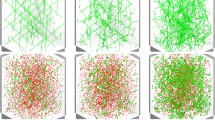Conclusions
The assumption of the existence in the microstructure of cold-worked material of dislocations having a preference for interstitial atoms (edge), and dislocations not having any preference (screw or mixed) can explain the observed decrease in dislocation density during the early stages of irradiation. This assumption also enables us to understand why the formation of a high dislocation density in a metal has a relatively small effect on the concentration and dimensions of interstitial dislocation loops formed in irradiation. Within the framework of the existing theory it is difficult to justify the assumption that screw dislocations are neutral sinks for point defects, since these dislocations have an edge component, and it would seem they should have a preference for interstitial atoms as pure edge dislocations do. However, the efficiency of dislocations as sinks may possibly not be determined by the drift of vacancies and interstitial atoms in elastic dislocation fields, but by a structural core of dislocations where trapping of point defects occurs. Unfortunately, the problem of the effect of a core of dislocations on the trapping of vacancies and interstitial atoms has not been adequately studied. Within the framework of the Heald and Speight mechanism of irradiation creep, relations were derived and analyzed which characterize the rates of irradiation swelling and irradiation creep in the presence of different types of dislocations, including those having a preference for interstitial atoms. It was established that taking account of neutral dislocation sinks does not change the theoretical conclusion that there is no simple linear relation between swelling and irradiation creep of a metal. The direct proportionality between swelling and creep deformation observed in certain cases can be explained by assuming that the strength of the sinks for dislocations predominates over the sink for point defects.
Similar content being viewed by others
Literature Cited
H. Brager et al., in: Proc. Int. Conf. on Radiation Effects in Breeder Reactor Structural Materials, Scottsdale, June 19–23 (1977), p. 727.
R. Bullough and M. Hayns, J. Nucl. Mater.,65, 184 (1977).
P. Heald, [1] in: Proc. Int. Conf. on Radiation Effects in Breeder Reactor Structural Materials, Scottsdale, June 19–23 (1977), p. 781.
P. Heald and M. Speight, Acta Metall.,23, 1389 (1975).
V. A. Pechenkin, V. I. Shcherbak, and Yu. V. Konobeev, in: Reactor Materials (Proc. Conf. on Reactor Materials), Vol. 2 [in Russian], Moscow (1978), p. 63.
H. Brager and J. Straalsund, J. Nucl. Mater.,46, 134 (1973).
P. Barton, B. Eyre, and D. Stow,ibid.,67, 181 (1977).
J. Harbottle and A. Silvent, in: Proc. Int. Conf. on Irradiation Behavior of Metallic Materials for Fast Reactor Core Components, Ajaccio Corse, June 4–8 (1979), p. 391.
G. McVay, L. Walters, and G. Hudman, J. Nucl. Mater.79, 395 (1979).
A. Boltax et al.,ibid.,65, 174 (1977).
J. Flinn, G. McVay, and L. Walters,ibid., 210.
Additional information
Translated from Atomnaya Énergiya, Vol. 50, No. 1, pp. 17–21, January, 1981.
Rights and permissions
About this article
Cite this article
Bondarenko, A.I., Konobeev, Y.V. Irradiation-induced swelling and creep of metals. At Energy 50, 20–24 (1981). https://doi.org/10.1007/BF01141247
Received:
Revised:
Issue Date:
DOI: https://doi.org/10.1007/BF01141247




